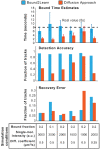Bound2Learn: a machine learning approach for classification of DNA-bound proteins from single-molecule tracking experiments
- PMID: 33744965
- PMCID: PMC8373171
- DOI: 10.1093/nar/gkab186
Bound2Learn: a machine learning approach for classification of DNA-bound proteins from single-molecule tracking experiments
Abstract
DNA-bound proteins are essential elements for the maintenance, regulation, and use of the genome. The time they spend bound to DNA provides useful information on their stability within protein complexes and insight into the understanding of biological processes. Single-particle tracking allows for direct visualization of protein-DNA kinetics, however, identifying whether a molecule is bound to DNA can be non-trivial. Further complications arise when tracking molecules for extended durations in processes with slow kinetics. We developed a machine learning approach, termed Bound2Learn, using output from a widely used tracking software, to robustly classify tracks in order to accurately estimate residence times. We validated our approach in silico, and in live-cell data from Escherichia coli and Saccharomyces cerevisiae. Our method has the potential for broad utility and is applicable to other organisms.
© The Author(s) 2021. Published by Oxford University Press on behalf of Nucleic Acids Research.
Figures





Similar articles
-
Super-Resolution Microscopy and Tracking of DNA-Binding Proteins in Bacterial Cells.Methods Mol Biol. 2016;1431:221-34. doi: 10.1007/978-1-4939-3631-1_16. Methods Mol Biol. 2016. PMID: 27283312 Free PMC article.
-
SMTracker: a tool for quantitative analysis, exploration and visualization of single-molecule tracking data reveals highly dynamic binding of B. subtilis global repressor AbrB throughout the genome.Sci Rep. 2018 Oct 24;8(1):15747. doi: 10.1038/s41598-018-33842-9. Sci Rep. 2018. PMID: 30356068 Free PMC article.
-
Super-Resolution Microscopy and Tracking of DNA-Binding Proteins in Bacterial Cells.Methods Mol Biol. 2022;2476:191-208. doi: 10.1007/978-1-0716-2221-6_15. Methods Mol Biol. 2022. PMID: 35635706
-
Trajectory Analysis in Single-Particle Tracking: From Mean Squared Displacement to Machine Learning Approaches.Int J Mol Sci. 2024 Aug 8;25(16):8660. doi: 10.3390/ijms25168660. Int J Mol Sci. 2024. PMID: 39201346 Free PMC article. Review.
-
Single-molecule fluorescence imaging of DNA maintenance protein binding dynamics and activities on extended DNA.Curr Opin Struct Biol. 2024 Aug;87:102863. doi: 10.1016/j.sbi.2024.102863. Epub 2024 Jun 15. Curr Opin Struct Biol. 2024. PMID: 38879921 Free PMC article. Review.
Cited by
-
CoPixie, a novel algorithm for single-particle track colocalization, enables efficient quantification of telomerase dynamics at telomeres.Nucleic Acids Res. 2024 Sep 9;52(16):9417-9430. doi: 10.1093/nar/gkae669. Nucleic Acids Res. 2024. PMID: 39082280 Free PMC article.
-
Single-molecule tracking for studying protein dynamics and target-search mechanism in live cells of S. cerevisiae.STAR Protoc. 2022 Dec 16;3(4):101900. doi: 10.1016/j.xpro.2022.101900. Epub 2022 Dec 5. STAR Protoc. 2022. PMID: 36595957 Free PMC article.
-
Disordered C-terminal domain drives spatiotemporal confinement of RNAPII to enhance search for chromatin targets.Nat Cell Biol. 2024 Apr;26(4):581-592. doi: 10.1038/s41556-024-01382-2. Epub 2024 Mar 28. Nat Cell Biol. 2024. PMID: 38548891 Free PMC article.
-
Impact of Saccharomyces cerevisiae on the Field of Single-Molecule Biophysics.Int J Mol Sci. 2022 Dec 14;23(24):15895. doi: 10.3390/ijms232415895. Int J Mol Sci. 2022. PMID: 36555532 Free PMC article. Review.
-
Editorial: Single-molecule studies of DNA-protein interactions collection 2021.Nucleic Acids Res. 2021 Jun 21;49(11):6005-6006. doi: 10.1093/nar/gkab497. Nucleic Acids Res. 2021. PMID: 34153108 Free PMC article. No abstract available.
References
Publication types
MeSH terms
Substances
Grants and funding
LinkOut - more resources
Full Text Sources
Other Literature Sources
Molecular Biology Databases

